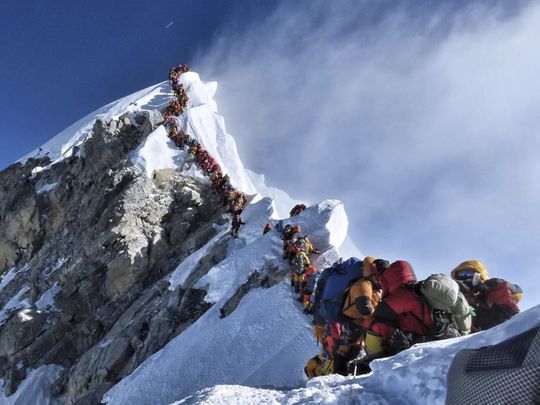
For those unfamiliar with the business of Mount Everest, a recent photo showing hundreds of climbers in a dense line snaking up the mountain’s southeast ridge on their way to the 8,848-metre summit was a shock. An American named Don Cash died in that traffic jam after being on his feet for more than 12 hours. Another American who made it to the summit and came down safely later told the New York Times, “It was like a zoo.” The Times blamed “fly-by-night adventure companies ... taking up untrained climbers,” the Nepalese government, “hungry for every climbing dollar it can get,” and “a growing body of thrill-seekers the world over” for the situation.
To many observers, this wasn’t just confirmation of the worst aspects of Everest’s reputation; it was a sign that today’s Everest climbers represent the height of human stupidity. But the situation on the summit this year is not reason enough to demonise those who were up there or who will go up there in the future.
I’ve been writing about the world’s highest peak as long as I’ve been a journalist, and I was on the scene at Base Camp, living with the Everest ER doctors, when, in April 2015, a massive earthquake triggered an avalanche that killed more than a dozen climbers — and almost killed me. Yet if someone offered me the chance to go climb Everest in the next few years, I would probably say yes. That wouldn’t mean just paying $70,000 (Dh257,075) for a one-time adventure. Before climbing Everest, I’d have to take mountaineering courses in the United States, an expedition to another 8,000-metre peak such as Cho Oyu and months off from full-time work. What’s lost in today’s conversation about Everest is how much time and effort the majority of climbers dedicate to preparing for their summit attempts.
Ill-prepared Everest climbers compromise the safety of other people on the mountain...Just because a massive feat of physical endurance is achievable doesn’t mean it’s easy.
Everest has had periodic PR crises since 12 people died during the spring of 1996 and Jon Krakauer condemned the commercial guiding industry’s foibles in his book Into Thin Air. Every few years, the cycle repeats itself: Faraway onlookers shake their heads, reporters write about how climbing conditions are worse than ever, and Nepal’s government officials, who control access to the mountain’s most popular route, make vague statements about imposing new rules.
I came away from my time at Base Camp feeling conflicted: So much obviously unnecessary death has occurred around this place, but if I had the means, I would go back as soon as I could. For all the bad it brings out in people, Everest will always be an invigorating, awe-inspiring wonder. To see it with your own eyes is a gift; to meet the people of Nepal’s Khumbu Valley is to be humbled and befriended in ways you never imagined.
I’m a distance runner, and I believe that, just like climbing Everest, pretty much anyone can run a marathon these days. That doesn’t mean running a marathon is easy or perfectly safe. Several people die running each year. But both pursuits are fairly irrational, require sacrifices and are not easily understood by those who say, “I would never do such a thing.”
Fortunately, if you can’t finish a marathon, you’re probably not going to hurt anyone else in the process. Ill-prepared Everest climbers compromise the safety of other people on the mountain. That’s a real problem that “the beauty and awe of Everest” can’t excuse. But it’s possible to hold all these thoughts at the same time: Just because a massive feat of physical endurance is achievable doesn’t mean it’s easy. And just because some people will attempt this feat without proper training doesn’t make everyone who does it an idiot. And it doesn’t make the pursuit itself stupid.
The Nepali government and certain guiding companies absolutely can do more to keep inexperienced climbers off Everest. The problem is not that too many people want to climb. It’s that a few guiding companies are willing to accept clients who aren’t ready to do it — and catering to their needs on the mountain is often what leads to deadly traffic jams.
There’s a lot to roll your eyes at about the modern Everest experience: the insanely luxurious accommodations some expeditions provide at Base Camp, the high sticker prices, the human waste. The endless superlatives climbers use to distinguish themselves and get funding for their trips: the youngest person, the oldest person, the first person with cystic fibrosis. (I could be the “first woman with Type 1 diabetes.”) So much of that deserves healthy cynicism. But the desire to test your own limits by walking to the top of the world on your own two feet remains pretty darn pure.
— Washington Post
Svati Kirsten Narula is an associate editor at Outside magazine.









